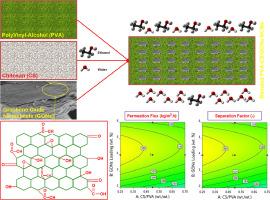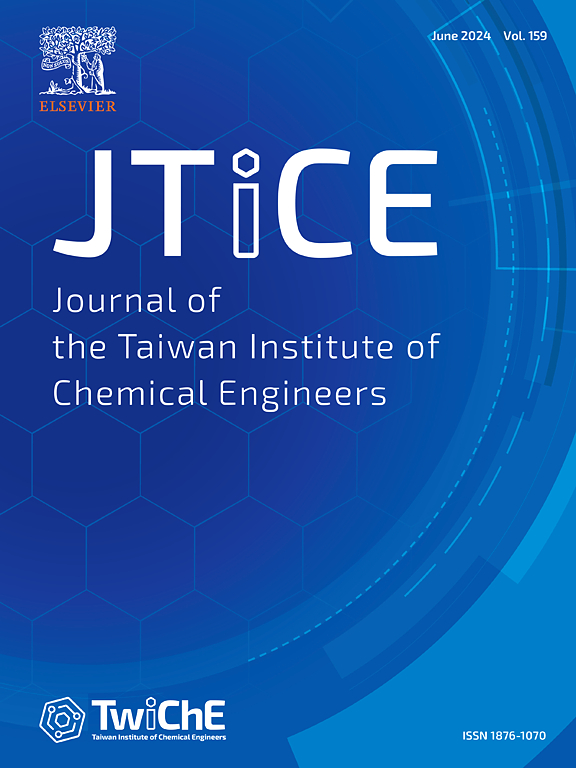利用响应面方法制备和优化纳米复合膜,用于通过渗透蒸发进行乙醇脱水
IF 5.5
3区 工程技术
Q1 ENGINEERING, CHEMICAL
Journal of the Taiwan Institute of Chemical Engineers
Pub Date : 2024-10-01
DOI:10.1016/j.jtice.2024.105790
引用次数: 0
摘要
方法将氧化石墨烯纳米片(GONs)加入壳聚糖(CS)和聚乙烯醇(PVA)的混合基质中,制备用于乙醇脱水的纳米复合膜(NCMs)。利用扫描电镜和傅立叶变换红外分析评估了膜的结构,并利用响应面方法研究了膜的脱水性能与膜组成(GONs 负载和 CS/PVA 混合比)和操作变量(进料温度和乙醇浓度)的关系。最佳 NCM 选定为 50 wt. % CS/PVA 混合聚合物基质,其中负载了 4 wt. % GONs,渗透通量(PF)和分离因子(SF)分别提高了 50 % 和 5 倍,达到 299 g/m2h 和 1142。当温度从 50 °C 升至 70 °C 时,其 PF 和 SF 分别达到 418 g/m2h(提高 45%)和 652(降低 30%)。当饲料中的乙醇含量从 80% 增加到 90% 时,这些值分别为 311 克/平方米小时(下降 25%)和 1106 克/平方米小时(提高 66%)。本文章由计算机程序翻译,如有差异,请以英文原文为准。

Preparation and optimization of nanocomposite membranes for ethanol dehydration via pervaporation by using response surface methodology
Background
Alcohol dehydration using pervaporation, as a fast-developing process, requires more facilitation by improving their membrane performance.
Methods
Graphene oxide nanosheets (GONs) were incorporated into blend matrixes of chitosan (CS) and polyvinyl-alcohol (PVA) to prepare nanocomposite membranes (NCMs) for ethanol dehydration. The membranes' structure was evaluated using SEM and FTIR analysis and their dehydration performance was studied against membrane composition (GONs loading and the CS/PVA blending ratio) and operational variables (feed temperature and ethanol concentration) using response surface methodology.
Significant Findings
SEM images revealed GONs uniform dispersion within the membrane matrix and the FTIR results revealed the hydrogen bonds formation and minor changes after GONs incorporation. The optimum NCM was selected as 50 wt. % CS/PVA blended polymer matrix loaded by 4 wt. % GONs with permeation flux (PF) and separation factor (SF) were improved by 50 % and 5-fold, to 299 g/m2h and 1142. Its PF and SF reached 418 g/m2h (45 % increment) and 652 (30 % decrement) as its temperature elevated from 50 to 70 °C. These values were measured as 311 g/m2h (25 % decline) and 1106 (66 % improvement) by increasing the feed's ethanol content from 80 to 90 wt. %.
求助全文
通过发布文献求助,成功后即可免费获取论文全文。
去求助
来源期刊
CiteScore
9.10
自引率
14.00%
发文量
362
审稿时长
35 days
期刊介绍:
Journal of the Taiwan Institute of Chemical Engineers (formerly known as Journal of the Chinese Institute of Chemical Engineers) publishes original works, from fundamental principles to practical applications, in the broad field of chemical engineering with special focus on three aspects: Chemical and Biomolecular Science and Technology, Energy and Environmental Science and Technology, and Materials Science and Technology. Authors should choose for their manuscript an appropriate aspect section and a few related classifications when submitting to the journal online.

 求助内容:
求助内容: 应助结果提醒方式:
应助结果提醒方式:


